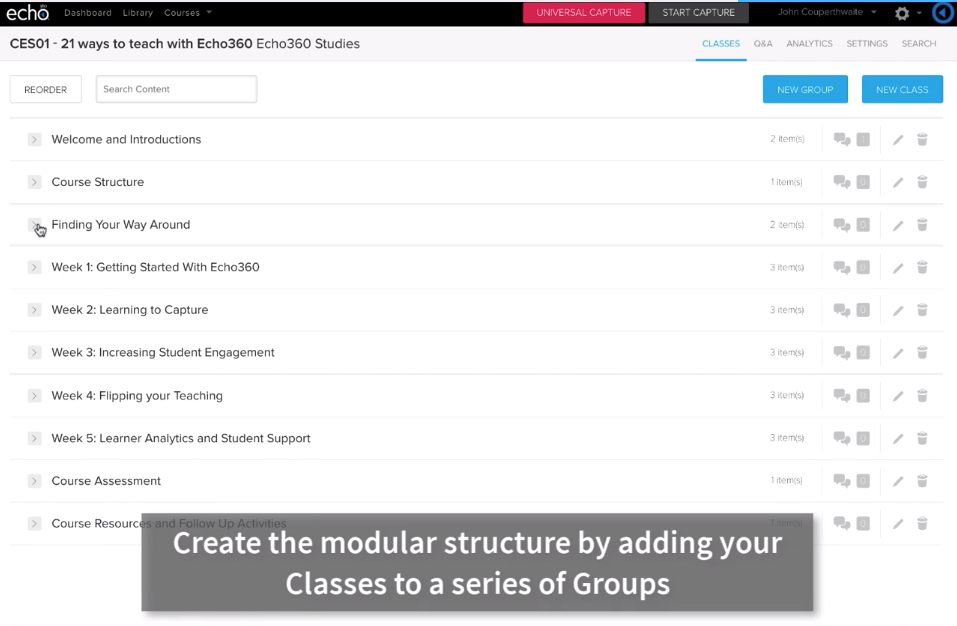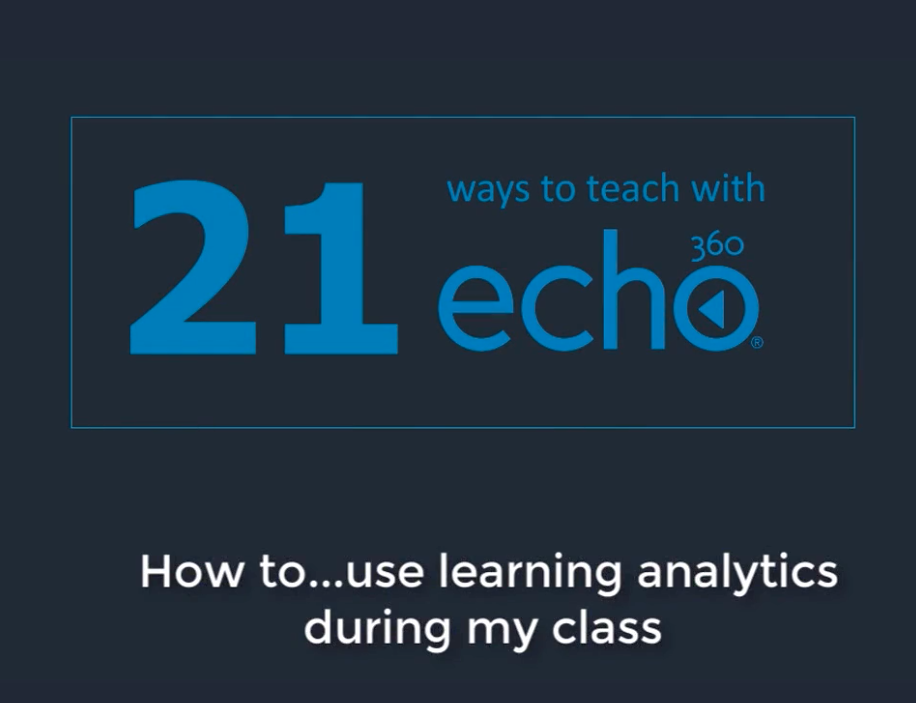Encourage Echo360 Active Learning
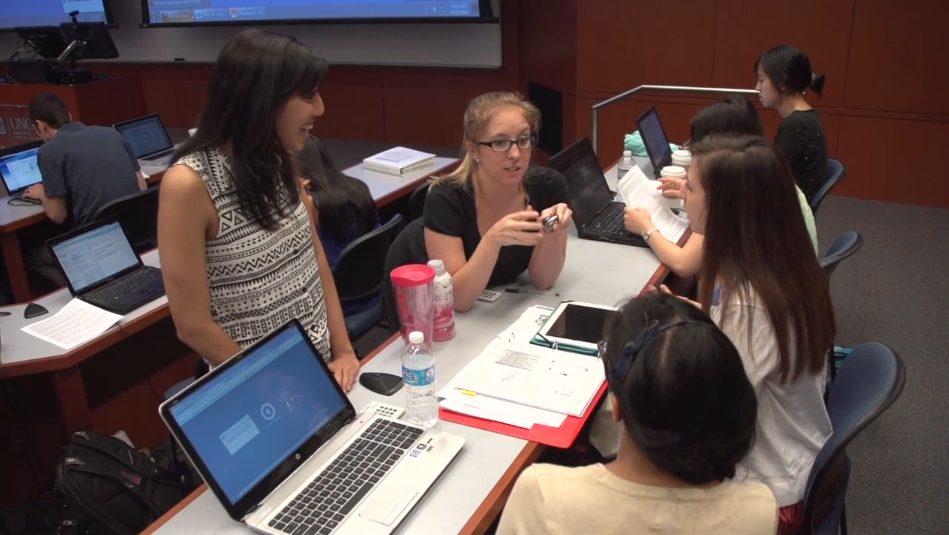
This is the twenty-second and final blog in our how-to series for educators and example 21 out of 21 ways to teach with Echo360. Read the introduction to this series here.
Why should I encourage active learning in my class?
Throughout this blog series we have seen various examples of how the engagement tools in Echo360 can be blended with teaching in the classroom or used to support distance learning in flipped or broadcast classes. These easy steps reward interaction by providing teachers with instant feedback of student understanding, and students benefit themselves by testing their knowledge with peers and being allowed to communicate ideas more freely. This approach has an impact on student grades too. A meta analysis of 225 different active learning studies in STEM subjects by Freeman et al (2014) identified increased grades and fewer failures, leading them to question the continued use of traditional lecturing in everyday practice. But beyond the technology, how can we motivate students to get involved, be confident participants, and be stimulated to learn more during class?
In this post, we will explore how active learning strategies can introduce effective ways to get students talking, sharing ideas and learning from each other. There are numerous excellent examples already available across many educational sites (see links included below), but this will focus on the more subtle arts of using the Echo360 engagement tools in class, learning from tried and tested methods used by expert practitioners.
And yes, as this is the 21st and last post in this series, it seemed entirely appropriate to include 21 tips on how promote active learning in your class.
How can I do that?
Before we get started, let’s take a quick recap on what is available for active learners in Echo360. Sure, we make the capturing lectures painless, but we also have a suite of tools for teachers and students to make class more interesting. Students can use these tools through their devices (browsers or apps) during class, allowing teachers to build clever combinations of interactions between their teaching delivery and this ‘lean-forward’ technology.
- Polling activities – teachers can add quiz and survey questions to their slides for students to complete in class; results can be shown immediately after the poll to reveal response and stimulate discussion.
- Discussions – teachers and students may post questions and responses during the class. Posts may be anonymous if desired. Posts can also be liked.
- Confusion alert – if students are confused at any stage during class they can click an alert button. Teachers can monitor these alerts and respond if they wish.
- Note-taking – students can make indexed notes throughout class. These are completely private to the individual and contribute towards other searchable metadata after class.
We must also be mindful that we are setting the right conditions for active involvement in our classes. Clear communication is vital, but so too are careful planning of your class, being familiar with your learning technology, and choosing activities appropriate for your space and technology. Neal (2010) outlines some of these factors in his ‘Preconditions for Active Student Involvement’:
Preparation
- Change student expectations on the first day and in the syllabus;
- Learn about your students;
- Use out-of-class assignments to prepare for active learning in-class;
- Prepare written instructions, worksheets, slides, etc., for the exercises.
Motivation
- Explain the educational purpose of the exercise to students;
- Create challenging exercises;
- Have students summarize what they’ve learned at the conclusion of the exercise.
Absence of Fear
- Provide a climate where risk-taking is rewarded;
- Allow students to get to know each other;
- Reward students for their participation with positive feedback;
- Practice “instructional immediacy” (smile, make eye contact, use student names, move around the classroom, etc.).
21 ways to promote active learning in your class
Now let’s look at how we can apply some of the active learning strategies. Some of these examples are simply designed to act as an icebreaker for a class but others can work in more structured lesson plans. I have also referenced the relevant Echo360 tool to use to apply these yourself.
- Mood checker – Sometimes it is good just to open class with a simple, “How are you?”. This icebreaker Poll question (MCQ or Open) is a greater way to sample the energy in the class and, because it is more likely to elicit a response than more challenging questions, it will give you a good idea about the number of students in attendance.
- Brain dump/Free write – Ask your students to make a Note of everything they know about an announced topic within a short specified timeframe. You could then invite students to verbally feedback, or to post their note anonymously into a Discussion thread and you select posts to read out to the whole class.
- 1 minute concept maps – Invite your students to create quick diagrams to show connections between major concepts. These could be posted to a Discussion thread as attachments, with Students being invited to compare posts and add comments.
- Note taking – Ask the entire class an interesting general question that relates to the topic under study. Have them write a Note about how they will respond. Discuss the question once most of the students have had a chance to respond. Allow time for students to write their answers before they discuss encourages participation.
- Notes exchange – During a lecture, ask Students to compare Notes on a key topic with a neighbour to clarify concepts, gain perspective on alternative ways to organize material, and reinforce the value of note taking.
- Muddiest (or Clearest) Point – At the end of a class, or at a natural break in the presentation, show an open Poll question, asking: “What was the ‘muddiest point’ in today’s lecture?” or, “What (if anything) do you find unclear about the concept of [insert topic here]?” This can be helpful feedback for you, and gives you time to address problem issues before your student leave the room.
- Affective Response – This is similar to the above exercise, but ask your students an MCQ or open Poll question to report their reactions to some aspect of the course material – i.e., to provide an emotional or value based response to the material. This can elicit some very different responses to simply being confused and can help with how you introduce difficult concepts in the future.
- Learning outcome checker – Ask your students to review the sessions’ learning outcomes and invite them to write a short reflection as a Note on either their current understanding of one of the outcomes, their confidence in the topic, or how it may relate to topics in other courses.
- Question, answer, discuss – Prepare a series of Poll questions to share in Class, but rather than use them to test knowledge, check your students’ understanding by reserving time after each question for either a verbal or online Discussion.
- One minute paper – Students are invited to write a 1-2 min response to an open Poll question. Topics may include, “What is the most important thing you learned?”; “Summarize today’s lecture in one sentence” or “What questions remain?” You might also include this activity throughout the lecture as a transition between topics, allowing them to reflect and summarize information, and identify what they do not understand, before moving on. An example of this is available on the Echo360 Blog.
- Discussion poll – Prepare a Discussion question and number of responses, similar to an MCQ question, in advance of beginning your class. During class, ask your students to vote on their preferred response by ‘liking’ it. These responses are anonymous and allow the whole class to get a instant impression of the class opinions. It is also dynamic, so students can ‘unlike’ and ‘like’ a different response as the voting proceeds. This is fascinating to watch and gives plenty of material to discuss afterwards.
- Clarification Pauses – To promote ‘active listening’, after stating an important point or defining a key concept, stop, let it sink in, ask them to make a Note and then (after waiting a bit!) ask if anyone needs to have it clarified. Select random students to read out their note or post it to the Discussion board.
- Response to a Demonstration or other Teacher-Centered Activity – Following a practical demonstration or activity, show an open question as a Poll activity and ask your students to write a paragraph that begins with “I was surprised that…,” “I learned that…,” or “I wonder about…” This allows the students to reflect on what they actually got out of the your presentation. It also helps students realize that the activity was designed for more than just entertainment.
- Focused discussion – Pause from teaching to invite students to respond to a provocative or challenging question in the Discussion. This requires students to think critically, and to evaluate their own and other’s responses. Students are able to explore a diversity of perspectives, and build on each other’s knowledge and understanding of the content. Discussions help students develop the skills of knowledge synthesis and integration. You may wish to respond as yourself, or anonymously, to stimulate deeper examination of topics.
- What’s Missing? – Reveal a list, diagram, picture, or series of steps related to the course content to your students, but omit a piece of information. Use the Discussion to challenge students to guess “What’s Missing?” from the list or image. Examples: list of steps to solve a problem, list of characters in a story, list of sections in a research paper, and a picture of equipment to be used in a lab experiment.
- “Ah-Ha!” Wall – Add a Discussion thread which invites students to post their Ah-ha moments during a class. For example, as students watch a video, participate in a lecture, or read an article, encourage them to pay attention to “ah ha” moments. An “ah ha” moment is when they notice the content is connected to another idea from the course, something they’ve experienced, or something related to a current issue. Ask them to post their “ah ha” idea as a response to your Discussion post. Review the wall in class and integrate their ideas into the lecture or choose posts from the thread to start a class discussion.
- Brainstorm ideas – Use an open Poll activity slide to invite students to brainstorm an idea. All responses are shown anonymously when the poll closes, allowing everyone to review each other’s posts, and a discussion to follow.
- Post question notes – As soon as you have discussed a general question as a whole group, have students then jot down a Note on what they heard that they agree with, disagree with, or that gave them a new idea.
- Collaborative Groups in Class – Pose a Discussion question and ask students to work with their neighbours in natural groupings. Ask a scribe to post the response to the Discussion. Use the responses to ask further questions. After an appropriate time for group discussion, students are asked to share an updated comment on their original response.
- Record and share – Ask your students to form pairs and invite them to post a short video clip to the Discussion board. The clip could be of feedback to an activity, a practical demonstration, an illustrated diagram, or an answer to a question.
- Rewarding engagement – Echo360 records details analytics on student interactions in class. These analytics can be expressed as an ‘engagement score’; this is simply a weighted average of each different recorded metric, with the weightings defined by the Instructor according to their mode of teaching. Students can be incentivized to engagement in class by offering assessment credits based on these engagement scores. For example, Andrew Perumal at the University of Massachusetts, Boston, awards up to 10% of the course grade based on in-class participation.
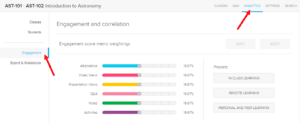
Watch this video to learn more about Engagement Scores, or read more about it in the Resource Centre.
Anything else I should be aware of?
Finding the right ways to ask the right questions is a skill in active learning sessions. It is equally important to encourage divergent viewpoints and responses. To promote debate, ask questions that might elicit differing opinions and allow multiple students to respond before weighing in or redirecting the conversation.
Give students some responsibility in asking good questions by establishing a framework that guides student generated questions. Giving students input can help students take ownership in the class discussion.
Be comfortable with silence. Studies suggests that if you wait briefly before calling on someone to answer, more students feel like they have time to think about a question, ensuring a higher quality of discussion.
You can use the Q&A page in Echo360 to monitor all your classes and their discussion threads. This means that post-class discussions can be accessed more efficiently.
All student names in anonymous discussion posts are viewable by Instructors. This can help with moderation of posts and supporting students. However, be wary of projecting the Discussion posts to a class full of students; it is better to hide/disable the projector if you wish to review the posts from the classroom PC.
All poll activity responses are available to view in the Analytics page. To access, click on Analytics from your Section page, select your class from the dropdown list, select ‘Activities’ from the next dropdown list. All activities for that particular class can be viewed by selecting them from the question dropdown box. Data can also be exported from the ‘Export’ page, accessed from the left menu bar.
Engagement tools are available through the web-based Echo360 environment or from our Apps (freely available for iOS, Android/Windows/Kindle). To learn more about how students can use the mobile app during class, see our Quick Guide to the Mobile Apps.
Does it work?
The review of 225 active learning papers from STEM subjects by Freeman et al (2014) is the largest meta-analysis of active learning studies to date. The outcome of the study suggests that traditional lecturing leads to a 55% increase in failure rates over active learning approaches. There was also no statistically significant variation in these results across the different STEM disciplines, suggesting that the results are consistent for all the teaching disciplines. The implication for teaching is that, at least for the eight STEM subjects considered, the use of active learning in class can deliver better grades for students.
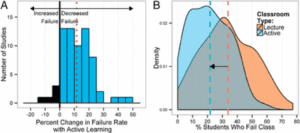
When Colin Montpetit introduced active learning into his level 1 Genetics class at the the University of Ottawa he was conscious of the risk of student non-engagement. To incentivise participation, Colin therefore offered 10% of the course grade based on their level of engagement in class and for some out of class activities. Students were given points for each answer submitted irrespective of correct or incorrect answers. If students answered 80% of the total questions asked throughout the term, they received full participation marks. If they participated to less than 80% submission rate, their participation mark was calculated as %submission rate/80. As a consequence, participation rates reached nearly 99% on some occasions. For Colin, the impact on student grades from 2011 to 2016 using the active learning tools in Echo360, revealed a similar pattern of results to the Freeman et al study. The chart below illustrates the progressive improvement in grades as Colin adjusted to using active learning techniques more fully in his classes.
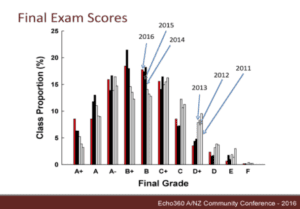
(Colin Montpetit, 2016, Echo360 ANZ Annual Conference)
Where can I find more information?
- Monitoring Q&A Discussion;
- Configuring your engagement score preferences;
- Increasing student engagement: creating student polls, questions and other activities;
- Increasing student engagement: facilitating in-class discussions and group work;
- Increasing student engagement, without recording;
- Practical Active Learning Ideas for Smaller Classes;
- 40 Active Learning Strategies for Active Students
In case you missed the previous posts in the series, here they are:
- Intro: A New Blog Series for Educators: 21 Ways to Teach with Echo360
- Part one: How to Record Your Class with Echo360
- Part two: How to Record an Asynchronous Screencast with Echo360
- Part three: How to Schedule Recordings of Your Classes with Echo360
- Part four: Lights, Camera, Action! Teaching and Live Broadcasting with Echo360
- Part five: Increasing Student Engagement: Creating Student Polls, Questions, and Other Activities
- Part six: Increasing Student Engagement: Facilitating In-Class Discussions and Group Work
- Part seven: Increasing Student Engagement: Delivering Live Interactive Teaching to Off-campus Learners
- Part eight: Increasing Student Engagement, Without Recording
- Part nine: Flip Your Teaching with Interactive Presentations
- Part ten: Flip Your Teaching with Seeded Discussions
- Part eleven: Flip Your Teaching with Screencasts
- Part twelve: Deliver Interactive Classes Using the PowerPoint Ribbon
- Part thirteen: Flip After Class with Discussions and Screencasts
- Part fourteen: Record in-class clinical procedures
- Part fifteen: Teaching to a class of distance learners
- Part sixteen: Facilitate discussions in small group teaching sessions
- Part seventeen: Create and Facilitate an Open, Online Course
- Part eighteen: Using Learning Analytics During my Class
- Part nineteen: Use Confusion Alerts to Review Teaching Delivery
- Part twenty: Create video-based learning activities in your LMS
Learn more about Echo360.



